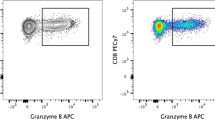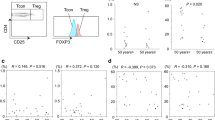Abstract
The proliferation of antigen-specific lymphocyte clones, the initial step in acquired immunity, is vital for effector functions. Proliferation tests both in immunology research and diagnosis are gaining attendance gradually, while the use of adult healthy individuals as controls of pediatric patients is a question. This study aimed to investigate and compare mitogen-stimulated proliferation responses of total lymphocytes and T- and B-lymphocyte subsets in adult and children healthy donors. Nineteen children and 20 adult healthy donors were enrolled in this study. Peripheral blood mononuclear cells (PBMCs) purified from peripheral blood samples of the donors, by Ficoll gradient centrifugation, were stained with CFSE and were cultured in a 37 ℃ CO2 incubator for 120 h with the absence or existence of polyclonal activators: PHA and CD-Mix. After cell culture, PBMCs were stained with monoclonal antibodies against CD4 and CD19, and proliferation percentages of CD4+ T and CD19+ B cells, together with total lymphocytes were determined by flow cytometry. This study revealed similarities between children and adult age groups, concerning mitogenic stimulation of the lymphocytes. The only difference was a significantly high proliferation of pediatric CD4+ T cells in response to PHA. CD4+ T cell responses against PHA were inversely correlated with altering age. When pediatric individuals were distributed into age groups of 0–2 years, 3–5 years, and 6–18 years, PHA responses of CD4+ cells were found to be diminished with advancing age. These findings propose the possibility of enrollment of adult healthy individuals as controls for pediatric patients.




Similar content being viewed by others
Data availability
The data related with this study is available upon request from the corresponding author.
References
Lyons AB, Blake SJ, Doherty KV. Flow cytometric analysis of cell division by dilution of CFSE and related dyes. Curr Protoc Cytom. 2013;Chapter 9:Unit9 11. https://doi.org/10.1002/0471142956.cy0911s64.
Marits P, Wikstrom AC, Popadic D, Winqvist O, Thunberg S. Evaluation of T and B lymphocyte function in clinical practice using a flow cytometry based proliferation assay. Clin Immunol. 2014;153(2):332–42. https://doi.org/10.1016/j.clim.2014.05.010.
Kervevan J, Chakrabarti LA. Role of CD4+ T cells in the control of viral infections: recent advances and open questions. Int J Mol Sci 2021;22(2):523. https://doi.org/10.3390/ijms22020523.
Zhu J, Paul WE. CD4 T cells: fates, functions, and faults. Blood. 2008;112(5):1557–69. https://doi.org/10.1182/blood-2008-05-078154.
Nowell PC. Phytohemagglutinin: an initiator of mitosis in cultures of normal human leukocytes. Can Res. 1960;20:462–6.
Cost KM, Fineman D, Steger S. A flow cytometry-based screening assay for lymphocyte proliferation. Clin Immunol Newsl. 1993;13(7):82–5. https://doi.org/10.1016/0197-1859(93)90012-9.
Fulcher D, Wong S. Carboxyfluorescein succinimidyl ester-based proliferative assays for assessment of T cell function in the diagnostic laboratory. Immunol Cell Biol. 1999;77(6):559–64. https://doi.org/10.1046/j.1440-1711.1999.00870.x.
Quah BJ, Warren HS, Parish CR. Monitoring lymphocyte proliferation in vitro and in vivo with the intracellular fluorescent dye carboxyfluorescein diacetate succinimidyl ester. Nat Protoc. 2007;2(9):2049–56. https://doi.org/10.1038/nprot.2007.296.
Lyons AB, Parish CR. Determination of lymphocyte division by flow cytometry. J Immunol Methods. 1994;171(1):131–7. https://doi.org/10.1016/0022-1759(94)90236-4.
Deniz G, Erten G, Kucuksezer UC, Kocacik D, Karagiannidis C, Aktas E, et al. Regulatory NK cells suppress antigen-specific T cell responses. J Immunol. 2008;180(2):850–7. https://doi.org/10.4049/jimmunol.180.2.850.
Kucuksezer UC, Palomares O, Ruckert B, Jartti T, Puhakka T, Nandy A, et al. Triggering of specific Toll-like receptors and proinflammatory cytokines breaks allergen-specific T-cell tolerance in human tonsils and peripheral blood. J Allergy Clin Immunol. 2013;131(3):875–85. https://doi.org/10.1016/j.jaci.2012.10.051.
Kucuksezer UC, Zekiroglu E, Kasapoglu P, Adin-Cinar S, Aktas-Cetin E, Deniz G. A stimulatory role of ozone exposure on human natural killer cells. Immunol Invest. 2014;43(1):1–12. https://doi.org/10.3109/08820139.2013.810240.
Palomares O, Ruckert B, Jartti T, Kucuksezer UC, Puhakka T, Gomez E, et al. Induction and maintenance of allergen-specific FOXP3+ Treg cells in human tonsils as potential first-line organs of oral tolerance. J Allergy Clin Immunol. 2012;129(2):510–20. https://doi.org/10.1016/j.jaci.2011.09.031.
Ekici Y, Yilmaz A, Kucuksezer UC, Gazioglu SB, Yamalioglu ZD, Gurol AO, et al. Combined evaluation of proliferation and apoptosis to calculate IC50 of VPA-induced PANC-1 cells and assessing its effect on the Wnt signaling pathway. Med Oncol. 2021;38(9):109. https://doi.org/10.1007/s12032-021-01560-4.
Jaye DL, Bray RA, Gebel HM, Harris WA, Waller EK. Translational applications of flow cytometry in clinical practice. J Immunol. 2012;188(10):4715–9. https://doi.org/10.4049/jimmunol.1290017.
McKinnon KM. Flow Cytometry: An Overview. Curr Protoc Immunol. 2018;120(5):1–5. https://doi.org/10.1002/cpim.40.
Azarsiz E, Karaca N, Ergun B, Durmuscan M, Kutukculer N, Aksu G. In vitro T lymphocyte proliferation by carboxyfluorescein diacetate succinimidyl ester method is helpful in diagnosing and managing primary immunodeficiencies. J Clin Lab Anal. 2018;32(1):e22216. https://doi.org/10.1002/jcla.22216.
De Stefano A, Boldt A, Schmiedel L, Sack U, Kentouche K. Flow cytometry as an important tool in the diagnosis of immunodeficiencies demonstrated in a patient with ataxia-telangiectasia. Lab Med. 2016;40(4):255–61. https://doi.org/10.1515/labmed-2016-0018.
Stone KD, Feldman HA, Huisman C, Howlett C, Jabara HH, Bonilla FA. Analysis of in vitro lymphocyte proliferation as a screening tool for cellular immunodeficiency. Clin Immunol. 2009;131(1):41–9. https://doi.org/10.1016/j.clim.2008.11.003.
Bonilla FA. Interpretation of lymphocyte proliferation tests. Ann Allergy Asthma Immunol. 2008;101(1):101–4. https://doi.org/10.1016/S1081-1206(10)60842-3.
Sallakci N, Tahrali I, Kucuksezer UC, Cetin EA, Gul A, Deniz G. Effect of different cytokines in combination with IL-15 on the expression of activating receptors in NK cells of patients with Behcet’s disease. Immunol Res. 2022;70(5):654–66. https://doi.org/10.1007/s12026-022-09298-5.
Tahrali I, Akdeniz N, Yilmaz V, Kucuksezer UC, Oktelik FB, Ozdemir O et al. The modulatory action of C-Vx substance on the immune system in COVID-19. Emerg Microbes Infect. 2022:1–28. https://doi.org/10.1080/22221751.2022.2125347.
Gelmez MY, Oktelik FB, Tahrali I, Yilmaz V, Kucuksezer UC, Akdeniz N, et al. Immune modulation as a consequence of SARS-CoV-2 infection. Front Immunol. 2022;13:954391. https://doi.org/10.3389/fimmu.2022.954391.
Choi P, Reiser H. IL-4: role in disease and regulation of production. Clin Exp Immunol. 1998;113(3):317–9. https://doi.org/10.1046/j.1365-2249.1998.00690.x.
Van Belle K, Herman J, Boon L, Waer M, Sprangers B, Louat T. Comparative in vitro immune stimulation analysis of primary human B cells and B cell lines. J Immunol Res. 2016;2016:5281823. https://doi.org/10.1155/2016/5281823.
Hui CW, Wu WC, Leung SO. Interleukins 4 and 21 protect anti-IgM induced cell death in Ramos B cells: implication for autoimmune diseases. Front Immunol. 2022;13:919854. https://doi.org/10.3389/fimmu.2022.919854.
Grossmann A, Ledbetter JA, Rabinovitch PS. Reduced proliferation in T lymphocytes in aged humans is predominantly in the CD8+ subset, and is unrelated to defects in transmembrane signaling which are predominantly in the CD4+ subset. Exp Cell Res. 1989;180(2):367–82. https://doi.org/10.1016/0014-4827(89)90064-5.
Song L, Kim YH, Chopra RK, Proust JJ, Nagel JE, Nordin AA, et al. Age-related effects in T cell activation and proliferation. Exp Gerontol. 1993;28(4–5):313–21. https://doi.org/10.1016/0531-5565(93)90058-l.
Kovaiou RD, Weiskirchner I, Keller M, Pfister G, Cioca DP, Grubeck-Loebenstein B. Age-related differences in phenotype and function of CD4+ T cells are due to a phenotypic shift from naive to memory effector CD4+ T cells. Int Immunol. 2005;17(10):1359–66. https://doi.org/10.1093/intimm/dxh314.
Acknowledgements
The authors like to thank Mr. Abdullah Yilmaz for his important assistance during the laboratory works.
Funding
This present work was supported by the Research Fund of Istanbul University. Project No. 29901.
Author information
Authors and Affiliations
Contributions
All authors contributed to the study conception and design. Zakya Shoub Elshari carried out the experiments, collected the data, and contributed in the initial draft of the manuscript. Serdar Nepesov, Ayca Kiykim, and Yildiz Camcioglu coordinated the establishment of donor groups and obtained the blood samples and also contributed in finalization of the manuscript. Ilhan Tahrali contributed in experiments, data analysis, and construction of graphics. Gunnur Deniz contributed in experiment design, discussion of data, and also proofreading. Umut Can Kucuksezer contributed in acquisition of adult samples, design and conduction of experiments, statistical analysis, graphics design, finalization of the manuscript, and proofreading.
Corresponding author
Ethics declarations
Ethics approval
This study was performed in line with the principles of the Declaration of Helsinki. Approval was granted by the local ethical committee of Istanbul University, Istanbul Faculty of Medicine (date: 23–06-2017/ no:817). The written informed consents for participation in this study were obtained from all of the participants or from their parents.
Conflict of interest
The authors declare that they have no conflict of interest.
Additional information
Publisher's note
Springer Nature remains neutral with regard to jurisdictional claims in published maps and institutional affiliations.
Rights and permissions
Springer Nature or its licensor (e.g. a society or other partner) holds exclusive rights to this article under a publishing agreement with the author(s) or other rightsholder(s); author self-archiving of the accepted manuscript version of this article is solely governed by the terms of such publishing agreement and applicable law.
About this article
Cite this article
Elshari, Z.S., Nepesov, S., Tahrali, I. et al. Comparison of mitogen-induced proliferation in child and adult healthy groups by flow cytometry revealed similarities. Immunol Res 71, 51–59 (2023). https://doi.org/10.1007/s12026-022-09328-2
Received:
Accepted:
Published:
Issue Date:
DOI: https://doi.org/10.1007/s12026-022-09328-2




